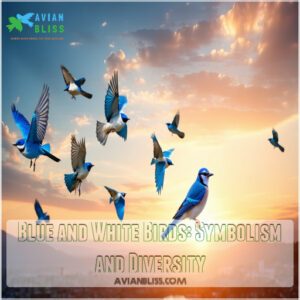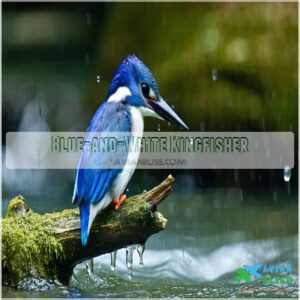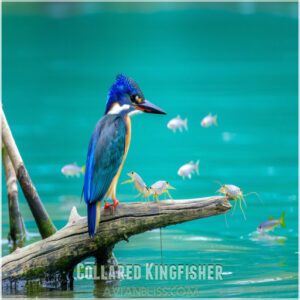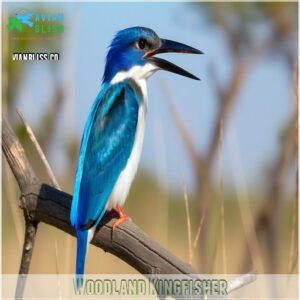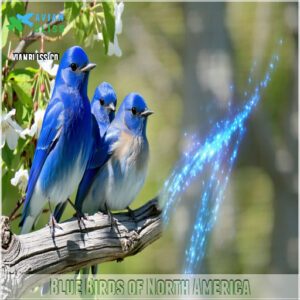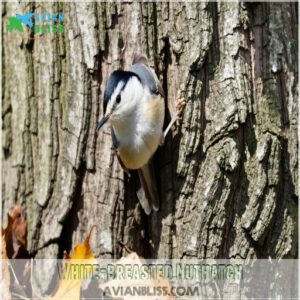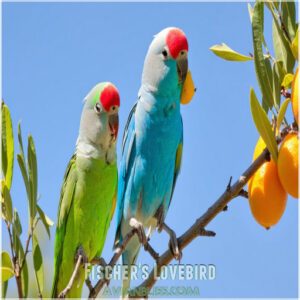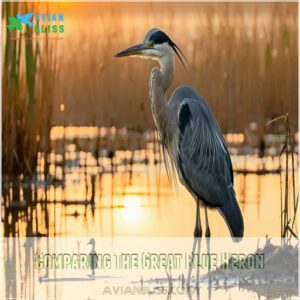This site is supported by our readers. We may earn a commission, at no cost to you, if you purchase through links.

The Mountain Bluebird, with its brilliant blue feathers and snowy belly, thrives in the mountains of western North America, while the bold Blue Jay struts through the forests of the East, famous for mimicking hawk calls.
In tropical areas, you’ll meet the soft-toned Blue-Gray Tanager, and near Asian wetlands, the striking Blue-and-White Kingfisher dazzles as it hunts fish.
Whether diving, flying, or singing, these birds remind us nature’s palette is unmatched.
Want to discover even more jaw-dropping species? Stick around!
Table Of Contents
- Key Takeaways
- Blue and White Birds: Symbolism and Diversity
- Notable Blue and White Birds
- Blue Birds of North America
- Endangered Blue and White Birds
- Blue Birds of Asia
- Blue Birds of The Americas
- Blue Birds: Uniqueness and Beauty
- Blue Birds of Africa
- Enhancing Birdwatching Through Recognition
- Comparing The Great Blue Heron
- Frequently Asked Questions (FAQs)
- What is a blue and white bird?
- How many types of birds are blue and white?
- What is an eastern bluebird?
- How long does a blue and white bird live?
- Do bluebirds have iridescent feathers?
- Where do blue birds come from?
- What kind of bird is blue and white?
- Are bluebirds rare to see?
- What state do bluebirds live in?
- What birds are mistaken for bluebirds?
- Conclusion
Key Takeaways
- You’ll find blue and white birds worldwide, from North America’s Mountain Bluebirds to Asia’s Blue-and-White Kingfishers, each thriving in unique habitats like forests, wetlands, or open meadows.
- Their vibrant colors aren’t from pigments but from feather structures that bend light, creating brilliant, iridescent blues that symbolize freedom, joy, and connection across cultures.
- Many species, like the Blue Jay and Woodland Kingfisher, display remarkable behaviors such as mimicking calls, diving for prey, or caching food for survival.
- Conservation is critical for endangered species like the Bali Myna and Blue-and-White Flycatcher, whose striking beauty highlights the need to protect delicate ecosystems.
Blue and White Birds: Symbolism and Diversity
There’s something magical about blue and white birds.
Their colors seem to blend the calm of the sky with the purity of clouds, creating a mix that’s hard to ignore.
Across cultures, these birds symbolize freedom, hope, and even spiritual connection.
Ever heard the phrase “bluebird of happiness”?
That’s no accident—bluebirds are often tied to joy and contentment.
Male Western Bluebirds sport vibrant blue plumage and rust-orange vests, as detailed in this informative bluebird resource.
But these feathered beauties aren’t just about looks.
Their feather patterns help them stand out during avian migration, making it easier to find their flock.
Plus, those vibrant blues and whites?
They’re part of nature’s survival toolkit, helping with courtship displays or blending into their surroundings.
From the bold Blue Jay to the delicate Mountain Bluebird, each species has a story.
Spotting one isn’t just birdwatching—it’s a glimpse into nature’s artistry.
So next time you see one, take a moment to appreciate its color significance and unique charm!
Notable Blue and White Birds
You’ll find some of the most striking birds in nature flaunting bold shades of blue and white, from shimmering kingfishers to graceful tanagers.
These species aren’t just pretty—they’re fascinating, with unique behaviors and habitats that make them stand out in the bird world.
Mountain Bluebird
If you’ve ever seen a streak of bright sky-blue gliding across a meadow, you’ve likely spotted a Mountain Bluebird (Sialia currucoides).
These stunning birds, with their vibrant blue plumage and snowy white bellies, call the open mountain habitats of western North America home.
Their feather patterns are like a piece of the sky come to life.
- Nesting habits: They use abandoned woodpecker holes or nest boxes.
- Diet: Grasshoppers, beetles, and other insects are their go-to meals.
- Migration: They follow food sources, heading to lower elevations in winter.
- Wingspan: About 14 inches, making them graceful fliers.
- Conservation: Efforts focus on preserving their breeding grounds.
Their cheerful bird songs and ground-foraging antics make them unforgettable among blue and white birds.
Blue Jay
If you’re into blue birds with bold personalities, the Blue Jay (Cyanocitta cristata) is a must-see.
Found across eastern North America, these blue and white birds thrive in forests and suburbs alike.
Their feather color is stunning—vivid azure with black-barred wings and a proud crest that screams confidence.
Known for their smarts and sass, Jay behavior includes mimicking hawk calls (just to mess with other birds) and stashing nuts for later.
Their diet? A mix of nuts, seeds, fruits, and the occasional insect.
When it comes to nesting patterns, Blue Jays build sturdy homes in tree forks, perfect for raising their noisy, curious young.
Bird watching just got a lot more exciting!
Blue-Gray Tanager
The Blue-Gray Tanager is a showstopper among blue and white birds, with its soft azure wings and dove-white belly.
Found in lush Tanager habitats across Central and South America, this charming blue gray bird thrives in tropical forests and gardens.
Their feather colors shimmer in sunlight, making them easy to spot.
- Why they’re unforgettable:
- Their cheerful chirps brighten any morning.
- They’re fruit lovers, often raiding backyard feeders.
- Their intricate nesting patterns hide their cup-shaped homes in dense foliage.
As partial migrants, their bird migration highlights the need to protect their vibrant homes.
Blue-and-White Kingfisher
The Blue-and-White Kingfisher is a showstopper among blue and white birds.
Found in Asian wetlands, their feather color gleams azure, paired with a sharp beak shape perfect for catching fish.
These skilled hunters perch near water, diving at lightning speed to snag prey.
Their kingfisher habitat overlaps with others, often leading to dramatic territorial displays.
Sadly, habitat loss threatens this stunning bird species, making their survival a pressing concern for conservationists.
Collared Kingfisher
With their vibrant feather colors, the Collared Kingfisher is a real showstopper among blue and white birds.
Found in mangroves and coastal areas from Southeast Asia to Australia, this blue and white kingfisher thrives in tropical settings.
These sharp-eyed hunters perch patiently, snatching fish and insects to satisfy their diverse kingfisher diet.
During breeding season, they dig nests into soft tree bark or termite mounds—prime real estate in their Kingfisher Habitat.
And their loud, rattling call? It’s nature’s seaside soundtrack!
Woodland Kingfisher
The Woodland Kingfisher is like a streak of brilliance across sub-Saharan Africa’s forests.
These striking blue and white birds light up the trees with their electric-blue backs and crisp white chests.
You’ll hear their loud, laugh-like calls echoing through the canopy, making them impossible to miss.
- Kingfisher Habitat: Found in woodlands, savannas, and forest edges.
- Feather Colors: Vibrant azure wings, a bright white belly, and jet-black beak.
- Flight Patterns: Quick, darting movements when chasing prey.
- Diet: Insects, small reptiles, and even amphibians.
Unlike many birds, the Woodland Kingfisher doesn’t migrate, choosing to stay put year-round.
Blue Birds of North America
You don’t have to look far to spot some of the most stunning blue birds of North America, from vibrant Eastern Bluebirds to bold Blue Jays.
These feathered gems brighten up forests, fields, and even your backyard, adding a touch of wild beauty you’ll never forget.
Eastern Bluebird
You know that flash of blue that zips by like nature’s confetti in motion? That’s likely the Eastern Bluebird – a favorite among blue and white birds in North America.
These small, vibrant songbirds thrive in open woodlands, grassy meadows, and even suburban backyards if given the right setup.
Males steal the show with their feather patterns: bright blue backs and rusty-orange chests, while females wear softer grayish-blue tones.
Their bluebird songs are sweet, soft whistles, often heard as they perch on fence posts or power lines, scanning for a tasty beetle or caterpillar.
In winter, they’re berry munchers, adding wild fruits to their diet.
Want to attract them? Install bluebird nest boxes in open areas, and you might see them checking out the neighborhood.
During bird migration, these blue bird species travel in small groups, proving there’s strength in numbers.
Who wouldn’t welcome them?
Budgie (Budgerigar)
If you thought the Eastern Bluebird was stunning, meet the Budgie.
These small parrots, often seen in vivid blue and white, bring personality to pet ownership.
Famous for their intelligence and charm, Budgies master Pet Training with ease.
Their Feather Colors stand out in any room, making them crowd favorites.
These birds thrive on Social Interaction—they might even out-talk you!
Endangered Blue and White Birds
Some blue and white birds are so rare, they’re in serious trouble, like the Bali Myna and Blue-and-White Flycatcher.
Protecting these endangered species isn’t just important—it’s a chance to keep nature’s treasures alive for future generations.
Bali Myna
The Bali myna is a striking white bird with bold blue eye patches and black-tipped wings, often called a "living jewel."
Found in limestone forests, it’s critically endangered, with fewer than 100 left in the wild.
Several North American bluebirds face different conservation challenges, as detailed on this informative bluebird webpage.
Here’s why it’s in trouble:
- Habitat loss wipes out breeding grounds.
- Poaching disrupts populations.
- Dedicated bird sanctuaries fight for species protection.
Blue-and-White Flycatcher
The Blue-and-White Flycatcher is a breathtaking blue and white bird with royal blue upperparts, a pure white belly, and a dark beak.
You’ll spot males flaunting their colors during Bird Migration from Japan to Southeast Asia, singing to defend their Flycatcher Habitat.
These skilled hunters snatch insects mid-flight, their quick movements mesmerizing.
Unfortunately, many birds face extinction due to habitat loss and other threats, according to current endangered bird lists.
While their Feather Colors dazzle, threats to their habitat mean they need protection.
A striking cousin to the blue and white kingfisher!
Blue Birds of Asia
In Asia’s lush habitats, blue and white birds dazzle with striking plumage.
Many other blue-colored birds exist across the globe, as detailed on this informative avian page.
The Indian Paradise Flycatcher steals the show, flaunting its sleek white body and vibrant blue crown, wings, and tail.
You’ll find them darting through dense foliage, showing off their incredible flycatcher behavior.
The blue and white flycatcher captivates during Asian bird migrations, flashing ultramarine feathers in courtship displays.
For kingfisher fans, the blue and white kingfisher is a stunner, thriving in tropical kingfisher habitats near rivers and coasts.
Blue Birds of The Americas
You’ll find some of the world’s most vibrant blue birds right here in the Americas, from forest canopies to desert scrublands.
With species like the lively California Scrub-Jay and the striking Black-throated Blue Warbler, these birds bring flashes of color to their habitats, almost like nature’s own confetti.
California Scrub-Jay
The California Scrub-Jay, a bold and clever blue and white bird species, lives along North America’s western coastline.
Known for its striking feather coloration—a rich blue on its head, wings, and tail, paired with a light gray underside—this bird’s beauty is unmistakable.
You’ll often spot it in chaparral and oak woodlands, where it thrives despite growing challenges like habitat loss.
These intelligent blue birds amaze scientists with their bird behavior, including memory feats where they cache and retrieve hundreds of food items.
Their varied scrub jay diet includes insects, acorns, and even small reptiles.
Plus, their nesting patterns showcase intricate problem-solving, proving nature’s ingenuity.
Black-throated Blue Warbler
The Black-throated Blue Warbler is like a hidden gem flitting through the eastern woodlands.
With its bold blue feathers and crisp white underparts, the male is impossible to miss—think of it as nature’s little sapphire.
The females? A bit more understated in olive-brown tones, but no less charming.
These small blue and white birds rely on a warbler diet filled with insects, often snatched mid-flight, with a side of berries during warbler migration.
You’ll usually find them nesting in dense understory from the Appalachians to Canada.
Sadly, climate change and deforestation are shrinking their homes.
Want to spot one? Listen closely to their sweet, buzzy bird songs echoing from the shadows.
Blue Birds: Uniqueness and Beauty
When you think of blue birds, their vivid colors make them unforgettable, but there’s so much more to their beauty than just feathers.
From clever problem-solvers like the White-breasted Nuthatch to the adorable Fischer’s Lovebird, these birds bring a spark of curiosity and charm to nature’s palette.
White-breasted Nuthatch
The White-breasted Nuthatch is a small wonder of the woods that you can’t miss.
This blue bird with white underneath scampers headfirst down trees like it’s defying gravity, earning it the nickname “upside-down bird.”
Its feather patterns of blue-gray backs and white faces make it both elegant and easy to spot for blue and white bird identification.
- Nuthatch habitat: Mature woodlands filled with tall, old trees.
- Bird feeding tips: They adore sunflower seeds, suet, and the occasional peanut!
- Tree climbing pros: Their claws help them grip bark like pros.
- Nesting behavior: They’ll stash food for winter, keeping territories tightly guarded.
To find one, just listen for their funny “yank-yank” calls—it’s their way of saying hello!
Fischer’s Lovebird
Tiny yet mighty, Fischer’s lovebirds are like the acrobats of the bird world!
Known for their playful antics and bold personalities, these blue and white birds dazzle with their array of color mutations, especially the vivid blue and white combinations seen in captivity.
Native to northern Tanzania, they thrive in small, tight-knit flocks, forming unbreakable pair bonds – talk about relationship goals!
Here’s a quick look at these vibrant companions:
| Trait | Detail |
|---|---|
| Scientific Name | Agapornis fischeri |
| Fischer Habitat | Northern Tanzania |
| Lovebird Diet | Seeds, fruits, veggies |
| Avian Health Tip | Strong social bonds essential |
Their cheerful chirps and joyful energy make them irresistible!
Blue Birds of Africa
You’ll find some of the most vibrant blue birds in Africa, where species like the Woodland Kingfisher and Masked Lovebird stand out.
Their striking colors, often paired with white patterns, make them a favorite for birdwatchers and nature lovers alike.
Masked Lovebird
The Masked Lovebird is a showstopper from Tanzania, boasting a bright blue body, crisp white chest, and jet-black facial mask.
These blue and white birds are playful, thrive on a seed-and-fruit diet, and form unbreakable pair bonds.
With Lovebird Behavior so lively, they’re like tiny comedians in feathers.
If you’re curious about their breeding habits or care, trust these social parrots to swoop in and steal your heart!
White-necked Jacobin
The White-necked Jacobin is a stunner among tropical birds, flaunting its neon blue feathers, emerald-green back, and bright white collar. This South American species dazzles bird lovers in Jacobin habitats across Mexico and beyond with its aerobatic skills and courtship displays.
- Males flash their blue head plumage during fancy mid-air dances.
- Diet: Nectar from tropical flowers fuels their high-energy lives.
- They’re pollination pros, keeping ecosystems thriving.
- Bird species quirks: A sharp contrast of glowing blue and snowy white makes them easy for blue and white bird identification.
White-throated Magpie-Jay
The White-throated Magpie-Jay isn’t your average blue and white bird.
With stunning turquoise wings and pristine white feathers, this flashy bird species steals the show in Mexico and Central America.
Their social structure is just as impressive—they forage in groups, chat with complex calls, and even share parenting duties through cooperative breeding.
These sharp problem-solvers craft intricate nests, showcasing clever nesting habits and adaptability.
Habitat conservation has kept their numbers stable despite environmental challenges.
With their aerial acrobatics and bold personalities, the Whitethroated Magpiejay is a true showstopper, proving resilience and creativity aren’t just human traits!
Enhancing Birdwatching Through Recognition
Want to ace blue and white bird identification? Start with binocular skills—spot the Mountain Bluebird’s brilliant blue before it’s gone! Explore bird species behavior—see how a Black-throated Blue Warbler hunts differently from a showy Blue Jay.
Join community birdwatching projects to track migration routes like a pro. A helpful blue bird identification guide can enhance your birding experience.
- Learn feather patterns: Recognize wing colors and beak shapes.
- Plan habitats: Map prime spots for catching those blue birds in action.
- Enjoy the moment: Birdwatching’s part discovery, part joy—don’t overthink, have fun!
Comparing The Great Blue Heron
The Great Blue Heron is the king of blue and white birds, thanks to its sheer size—four feet tall with a six-foot wingspan.
Its sleek blue-gray feathers, white face, and dramatic black head plumes make it unforgettable.
Found in diverse Heron habitats, from wetlands to suburban ponds, it’s a patient hunter, freezing like a statue before snatching prey.
They primarily consume fish, frogs, and rodents, exhibiting diverse foraging strategies and techniques.
They migrate bravely, flying miles, but some stick where water stays unfrozen.
Spot one at dawn or dusk and witness true blue-bird magic!
Frequently Asked Questions (FAQs)
What is a blue and white bird?
A blue and white bird is a feathered beauty with striking blue tones and crisp white accents.
These birds, like the Blue Jay or Mountain Bluebird, stand out with their vibrant colors and unique patterns.
How many types of birds are blue and white?
There are over 20 types of blue and white birds worldwide, including favorites like the Blue Jay, Mountain Bluebird, and Kingfisher species.
From jungles to backyards, they bring vivid beauty wherever they go!
What is an eastern bluebird?
An eastern bluebird’s a small songbird with vibrant blue feathers on its head and back, a reddish-orange chest, and a white belly.
They’re bug-munching insectivores, often found in open fields, orchards, or backyard gardens.
How long does a blue and white bird live?
You won’t believe it, but bird lifespans vary wildly.
Smaller ones like wrens stick around 2-5 years, while larger ones, like blue jays, can surprise you by living over a decade in the wild.
Do bluebirds have iridescent feathers?
Yes, bluebirds have iridescent feathers.
Their vibrant blue color isn’t from pigments but from how light bends through microscopic structures in their feathers.
It’s like a tiny science experiment happening on their wings—pretty cool, right?
Where do blue birds come from?
Bluebirds come from North America, thriving in open fields, woodlands, and grasslands.
You’ll spot them from Canada to Mexico, depending on the season.
Their habitats fit their diets of insects, berries, and seeds perfectly.
What kind of bird is blue and white?
It’s funny how nature loves pairing blue and white on birds.
Think of the Eastern Bluebird or the Tree Swallow—each flaunts sky-blue feathers with snowy white bellies, like art straight from nature’s palette!
Are bluebirds rare to see?
Spotting a bluebird isn’t super rare, but it’s not an everyday thing either.
Their bright blue feathers pop in open fields or woodlands.
Keep an eye out during spring—they love showing off then!
What state do bluebirds live in?
It’s almost unfair how bluebirds seem to have claimed the whole United States.
They live everywhere from Florida’s warm scrublands to Montana’s breezy meadows, thriving wherever they find open spaces, trees, or yummy insects.
What birds are mistaken for bluebirds?
You might confuse Tree Swallows, Indigo Buntings, or Belted Kingfishers for bluebirds.
Their vivid blue feathers or similar size can trick your eyes, but each has distinct markings and habits—look closely to spot the difference!
Conclusion
Like a colorful stamp collection, blue and white birds showcase the planet’s stunning variety.
From the Mountain Bluebird’s alpine flair to the Blue Jay’s cheeky mimicry, each species adds a unique charm to nature’s masterpiece.
Whether soaring through the Americas or perched in Asian wetlands, these feathered wonders invite you to explore their habitats and behaviors.
So grab some binoculars, step outside, and you might just spot one of these beauties brightening up your day!

